Taking advantage of a 40% drop in tourism and a $13M to $1US exchange rate, we left South Texas April 8, 2009 to spend semana santa (holy week) in the State of Coahuila and traveled to Monclova, Quatrocienegas, Torreon, Parras de la Fuente, and the capital, Saltillo. We found excellent accommodations going begging -- in no small part because narcotraficante violence has scared other tourists away. In some cases we had whole cities almost entirely to ourselves. Gas was about 80 cents higher than in the States, the Mexican petroleum industry being state-owned, with resultant price controls. But although we took toll roads (cuotas) when available, we still did the five-day trek for about $350 each, including a bit of shopping. There were some surprises...and some disappointments.
We entered via Piedras Negras (across from Eagle Pass, Texas), mostly because I was wary of crossing at the shorter point, Nuevo Laredo (so plagued with drug violence that even the famed Cadillac Bar, re-christened the El Dorado due to an internecine squabble, shut down), and also because one of the guide books said that the Piedras Negras crossing was quicker. It did not say that the aduana (customs) offices, where both visas and temporary auto importation permits are dolled out, is in the town of Allende, about 30 miles from the border. As it happened, the document procurement was no more streamlined than at Matamoros, where we crossed last October (2008), but that crossing was very much out of the way for so westerly a trek.
The drive from Allende to Monclova is surprisingly lacking in the sort of monotony characteristic of the Reynosa-Monterrey approach: rolling, arid hills give way to a variegated landscape, with an occasional outcropping of mountainous rock and a sharp curve or two. The outskirts of Monclova herald an oasis complete with palms, and the city is quite pretty in the suburban hills to the west of the main drag; the shabbier centro lying to the east about a zocalo dominated by a giant foundry crucible, a sculpture erected in honor of the founding father, whose Altos Hornos iron and steel works (Ahmsa) employs many locals.
We found acceptable quarters at a Lonely Planet recommendation, the Hotel Olimpia, just off the square ($41) and ate some antojitos for dinner at a popular cafe on the square. We spent about 45 minutes looking for a nicer accommodation, asking several policemen how to get to the Chulavista de Monclova. We never did find it, but our search introduced us to the ritzier suburban side of town on the west side of Highway. This is an upscale area, and it was enjoyable driving through it at sunset.
The next morning, we headed for Cuatrocienegas, stopping off briefly on the outskirts to shoot pictures of an enormous equestrian statue of revolutionary hero Venustiano Carranza on top of a hill overlooking the city. The view from the top is spectaclular, but you cannot see the primordial desert spring-fed pools lying further west of the small city. Cuatro has some good hotels for a desert town, including the Plaza, in whose La Casona we ate a hearty breakfast. The Museo Carranza just a block or two away from the zocalo is worth a look; I had not known that the man had been governor of Coahuila prior to his march south as part of the same forces that would include Villa.
We had heard much of the Area de Proteccion de Flora y Fauna lying outside the town, about ten miles away. True, the Poza Azul is a wondrous sight: a many-hued pool of water fed by springs gurgling up from subterranean desert. As we had seen in online photos, small fish were feeding on the bottom, some not found anywhere else in the world, but the postcard views we'd seen were not to be found. The visitors' office seemed to have upped the entry fee just for semana santa, a minor annoyance. We didn't visited the other pools: Tortugas, Mezquites, Bezera, and Churince, as we figured we'd be paying extra for a swim. (Swimming is not allowed in Poza Azul.)
The water in the lagoon at Poza Azul was quite startling, however: so many shades of blue (as I hope my photo reveals), though the setting was somewhat spoiled by the occasional piece of trash, including a polyvinyl drink container that had floated up to the marshy weeds along the banks. When we walked back to our car (one can drive to the site, but we thought it would cost extra) a trio of park ranger vehicles, complete with whirling overhead lights, roared past, and as they returned only moments later, we assumed the tour of the area was mostly for show. We drove on, past Poza La Becerra, which appeared closed. Although one can swim at La Becerra, we were in a hurry to get to Torreon, which we had not seen since a childhood trip from South Texas to Mazatlan over the hairpin Highway 40 out of Durango. (It was under construction at the time and we had memories of having to back up great distances to allow heavy earth moving vehicles to pass, one way, and of delays for dynamite as well.
This time, however, we only wanted to go as far as Mapimi, the desert town northwest of Torreon, where, oddly, many revolutionary heroes passed through on their way to one destiny or another. Lonely Planet is unfair to Torreon, calling it "one ugly city." If you peruse their minuscule section on the place, you see that they spent very little time here, haven't updated their listing, and treated it as a stopover-only last resort. It isn't. It is worth exploring all for itself. Their writer recommends the Hotel Palacio Real on the zocalo, which we found lacking in any charm or amenities, a pensioners' public housing haven (the plaza itself is down in the dumps and has nothing to recommend it, all the nice stores having moved out to the malls on the main drag, Independencia). While looking for another hotel listed at www.allmexicohotels.com (a good resource for the traveler to Mexico if you take the star rating system with a grain of salt), we stumbled upon the Hotel Calvete, surely the best of the moderately priced inns in this city of a half million.
We ended up staying at the Calvete two nights, as we set out for Mapimi and the mine at Ojuela before noon the next day. But I am getting ahead of myself. That night we went out for dinner, heading for a "Spanish" restaurant advertising paella in one of those "attractions" maps you sometimes find in hotel lobbies. Instead of making bets that a Mexican paella would taste fairly fake to anyone who has been to Spain and had the real thing (as both of us have), we should have bet we couldn't find it, which we didn't. Instead, we found a place featuring meat grilled al pastor and arrachera in particular, grilled (asada) top sirloin. This was the Xotepingo, also on Independencia.
I made the mistake of ordering a milanesa, the Mexican version of Vienese veal scallopini, only made with thin beef. It was good but I've had better. Terry wisely ordered the speciality of the house, arrachera, and didn't stop talking about how good it was for the rest of the trip. The Xotepingo, which has branches all over both Torreon and Durango, is a must if you're passing through. The portions are generous and the management lays on plenty of sides and totopos with salsa. We looked forward to eating there a second time when we got back from our trip to Mapimi but, alas, it was Good Friday and, like many businesses in town, the Xotepingo was closed. We did have a substantial breakfast at a local VIP'S, before setting out for Mapimi and the Ojuela mine. Again, Terry enjoyed his huevos divorciados, so-called because it consists of two fried eggs on opposite sides of an oval platter. Actually, we only ate at VIP'S because it was the only place open at 8 a.m. I was less enthusiastic about my eggs with bacon and hot cakes.
We spent a good part of the morning looking for one of the local museums, the Museo de la Revolucion at Lerdo de Tejada and Calle 10. This is a good place to familiarize yourself with the history of the revolution of 1910-1924 and, in particular, that part of the war in the North pitting federal troops against the legendary Division del Norte, peopled by the likes of Carranza, Madero, and Villa. Located in a restored (and resplendent) private home -- that of Dr. J. W. Lim, dating to the turn of the last century. Interactive videos show how the revolutionary troops armed themselves, traveled south by train, and me up, eventually, with their southern counterparts, including Zapata. We got lost looking for the place and a young couple in a VW bug with a local TV station's logo on the side graciously led us to the building. Torreonos go out of their way to be nice to tourists!
The drive out to Mapimi later took us through Torreon's sister city, Gomez Palacio, which has nothing to recommend it, though we did notice it is cleaner than Torreon. We found the turn-off from Highway 45 from Torreon to Chihuahua, and had an uneventful drive until we got to a point about a mile out of Mapimi. We were forced to stop when we pulled up behind taxi cabs, pickups, and other vehicles, all haulted in the middle of traffic. Off to the left we saw a hill rising about 500 feet from a path less than a quarter mile from the road. On top of the hill were three crosses; we immediately realized we had come upon a religious procession -- an Easter pageant.
Mexicans really go in for recreations of the crucifixion -- and how. Not only were amateur actors playing Jesus and the thieves, there were more than a few Roman centurians; in fact, about thirty of them. It is beyond me (and certainly beyond my ability to believe) why anyone would want to play a Roman in an Easter crucifixion play, but there they were in their cardboard armor, painted silver, with whips and scourges pushing a reluctant Christ forward across the highway, down a gulley, over the path to the hill, and up and up to the local Golgotha. In all, our delay lasted about thrity minutes, but it gave Terry time to get to know a taxi driver who, after all, was in the same predicament.
Mapimi is a small town, celebrated for its church steeple peppered and now pocked with revolutionary bullets. It has quite a proud history. Mapimi was founded in 1589, primarily as a service town for the nearby Ojuela Mine, which we passed on the way in, deciding to see when doubling back. When the French chased Benito Juarez north, the father of Mexican independence stopped here. Another revolutionary, Father Miguel Hidalgo, wound up in a jail cell in Mapimi in 1811. We dipped into a tienda on the plaza to buy some cold drinks, and I found another opportunity to pass out McDonald's Happy Meal toys, which I always take along as gifts for the local children.
The mine at Ojuela is only accessed by a 1,040-foot-long suspension bridge dangling perilously above a canyon gorge some 330 feet deep. As I have acrophobia, I made sure to hang onto the railings while crossing. The setting is quite spectacular (I kept hearing the music from Treasure of the Sierra Madre as I inched my way down the floor of the bridge), and for a small fee, one can make the return by zip-line. Both of us agreed this was not our cup of tea. We did go on a tour of the mine, however. Its highlight, if you can call it that, is a dead mule perfectly preserved by the minerals of the mine, much like the bizarre "mummies" in the panteon in Guanajuato.
On the trip back to Torreon, we stopped off in some rock shops. These are plentiful but only sell quartz and other minerals, nothing even semi-precious. The small town of Bermejillo is full of such stores, and it is a good place to gas up and dip into one of the ubiquitous Oxxo's. Let me say here that I, for one, don't know how we ever got along with these spotlessly clean, fully-stocked, well-operated convenience stores. You can get anything from toilet paper to cold beer and all of the prices are scanned by bar code, no chance of a chingle here. Some even have restrooms, quite a nice change from the disgracefully dingy toilets you find in most of the Pemex stations. There, you need to take your own paper and have a few peso coins to deposit into the hands of the cleaning staff, or stuff into an electronic door opener.
That night, Good Friday as it was, we were disappointed to find that the Xotepingo was closed. We had to eat at one of the few places open for the holiday, a Pollo Loco, which is actually pretty tasty, though nothing at all like our "Southern fried chicken." It is grilled but inexpensive and delicious. We are not night people now that we've ceased our libational habits, so I cannot report on what sort of night life Torreon boasts. From the laughter and good cheer exhibited by young people having beers at the Xotepingo the night before, I gather the party scene is alive and well there.
In the morning, we set off for Parras de la Fuente. It's about thirty minutes off the toll road, but the drive is a pleasant one, desert cactus slowly being replaced by leafy green trees. The Parras area flora is fed by underground springs, which allows cultivation of a lot of pecan trees and the agricultural produce Parras is famous for: grapes. As we drove into town, we noticed that to the left of the highway is a huge public park, occupied by hundreds of families who were cooking out, picnicking, and socializing. Their vehicles were parked alongside the road, bumper to bumper. I knew that Semana Santa is celebrated in somewhat different ways in different parts of Mexico, the big party in Jerez, near Zacatecas, being one of the most popular (and perhaps the craziest, with lots of horseback riding in the streets, firing of pistols, and so forth). We tried to get coffee in an Oxxo and had to stand in long lines, the crowd was so large.
We had to kill some time waiting for a room at the Hotel Posada Santa Isabel, just off the plaza. Although a bit cramped, the room was modern and comfortable. I am left to wonder if Mexicans read in their hotel rooms, so many of them have lousy lighting, e.g. lamps with fixed shades that don't allow light to spill farther than a pillow. Who reads a book with the pages touching their nose? The grounds at the Santa Isabel are shaded by pecan trees (Lonely Planet erroneously indicates avocados); during the night, a wind storm blew in and shook the branches, causing a few tiny pecans to fall to the grass.
After checking in, we drove out to San Lorenzo to the Casa Madero, a winery established in 1597, that has been producing varietals ever since. We took a free tour of the extensive grounds -- quite impressive, complete with a sampling of their brandy -- and shopped for friends in the bottle store. Returning to Parras, we barely had enough time to eat at the restaurant of the Hostal El Farol, about a block away, before the festivities of Holy Saturday began -- signaled by pyrotechnical destruction of the Satan piñatas.
The square was crowded like a sardine can, full of revelers listening to a music group. On our way over, we passed a gaggle of young people who begged us to shoot their picture. I even took a shot of the Semama Santa Queen, much to the consternation of her parents. (They must have thought we had ulterior motives.) After a stroll around the plaza, during which we bemoaned the old custom of the weekend parades, young men going in one direction, young women and their chaperones going the other way, a practice that has all but disappeared in modern Mexico.
In the morning, we had freshly-prepared menudo at a little greasy spoon next to the bus station. I've never understood some peoples' aversion to this dish. Its detractors describe the tripe as "squishy," "yucky," and worse, but I find it a delightful breakfast even though I no longer feast on it when I have a hangover, as I no longer drink. (The tiny thimble-full of brandy at the Madero Winery reminded me of my decision to get off the sauce.) Of course, it is impossible to eat menudo without the proper condiments, and in fact I cannot think of doing so unless I add them: fresh lime juice, a sprinkling of chopped serrano peppers, chopped white onion, and Mexican oregano. (Mexican oregano is not the same plant as European oregano; it is related to it, but much, much stronger.) I doubt that menudo "cures" a hangover so much as it helps settle the stomach.
We went shopping for local specialties, including a kilo of chorizo from a shopwoman's own kitchen, proudly displayed in the doorway of her house, which also served as her showroom. The back walls were lined with shelves of flavored sirups made of coffee, blackberries, and other things. She told us she used only a small amount of alcohol in their preparation, so I bought a bottle, and Terry bought some campechangas, little wafer-like sweet crackers with a sugar glaze, quite delicious. These were offered all over town, and it amazed us that so many shops had a product that one would not expect to encounter so far from Campeche, on the Yucatan Peninsula.
Then we left for Saltillo. I had been to Saltillo on several occasions, but never really spent any time in the historical center. I was amazed at what I had been missing: Saltillo is a modern city with colonial touches, e.g., the main cathedral, an 18th century structure set back from the Plaza de Armas where impressive statues and fountains treat pigeons and lovers. After checking into our room at the impressive Hotel Urdiñola, we did a lot of walking: to the public market on Allende north of the plaza, to the Serape de Saltillo, an artesanias shop on Hidalgo to the south. We also ate cabrito at the Restaurant El Principal, pricey but delicious. (It's about four blocks further up Allende from the Mercado Juarez.)
We did not get to shop at the Serape until the following morning, a Monday, and before that we had breakfast at the Flor y Canela, a chi-chi eatery with front windows looking out on the plaza. The food here is good, but the crafts at the Serape are insanely expensive. Almost all of its artesanias are sold along the border at much reduced prices, but we knew we probably would not have time to stop in Reynosa on our way home, so we went ahead and bought items, including a hand-woven cushion cover. (The have a weaver at work right there in the store.)
We arrived at the border mid-afternoon, took care of business, including surrender of our temporary auto importation sticker and U.S. customs on the other side of the river, and drove on home. All in all, it was a nice trip and a great introduction to the State of Coahuila.
Subscribe to:
Post Comments (Atom)



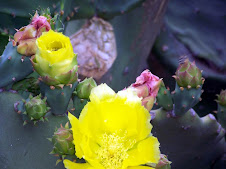


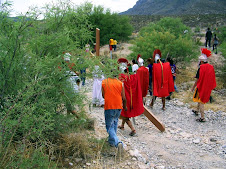
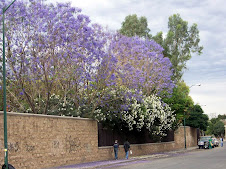





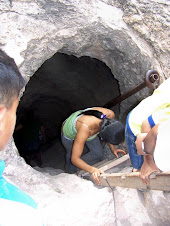
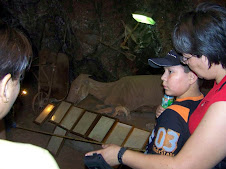


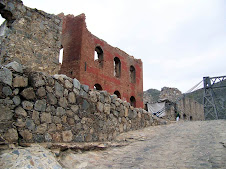



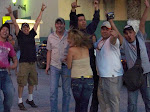
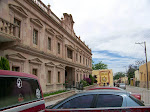



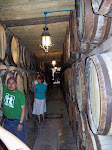


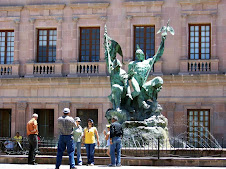






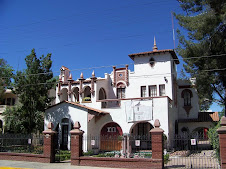







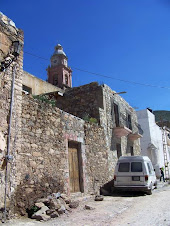






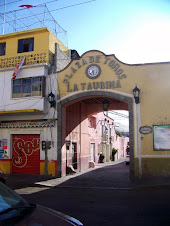
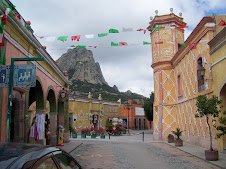




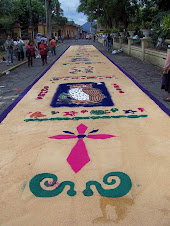


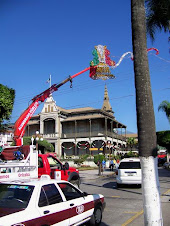
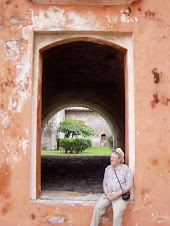

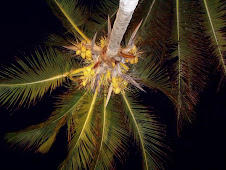




No comments:
Post a Comment